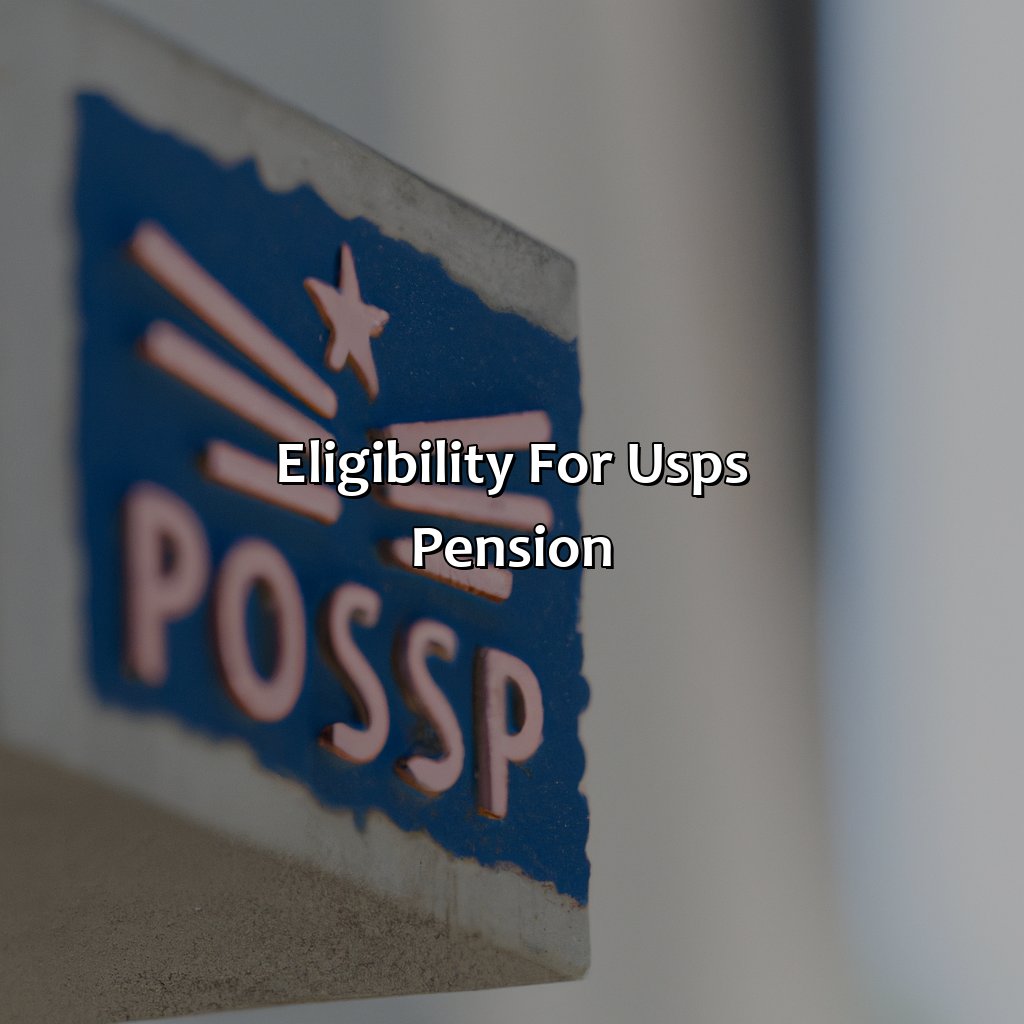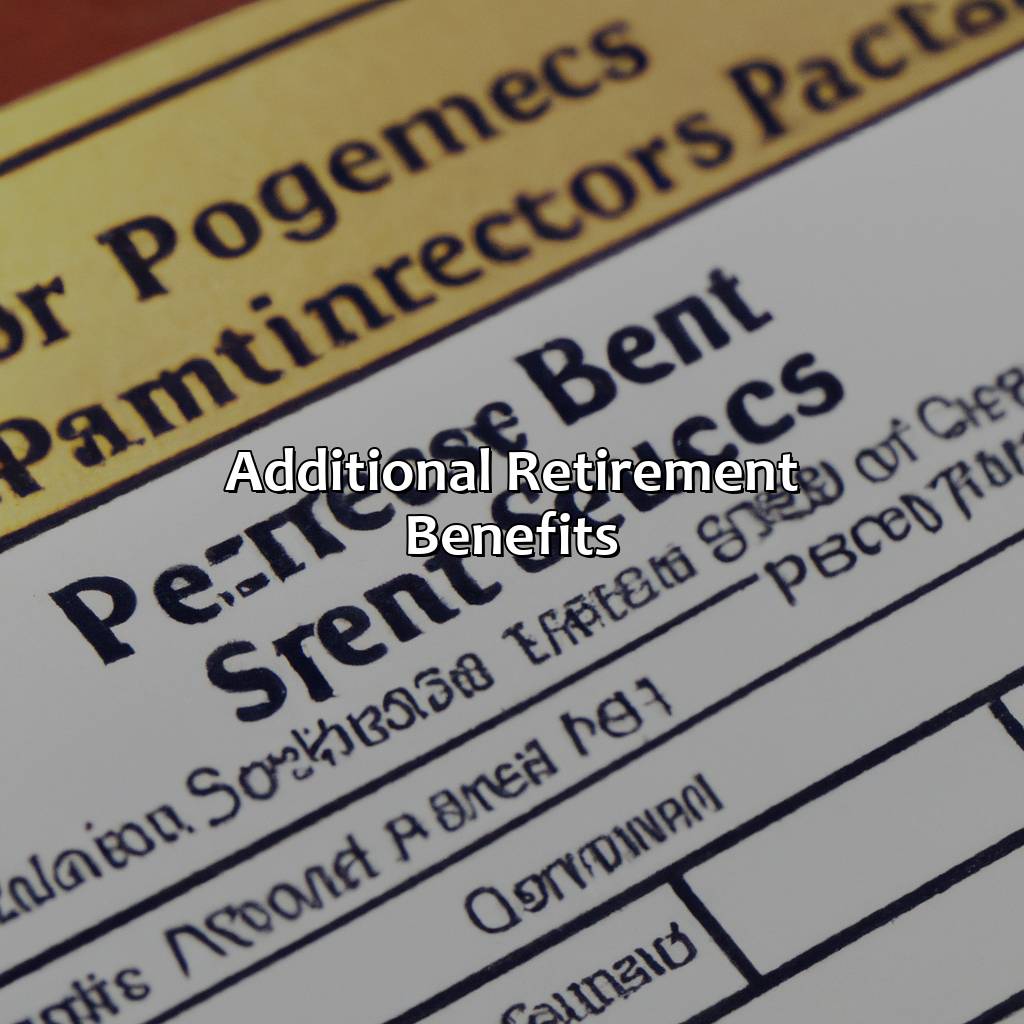How Long Do You Have To Work For Usps To Get A Pension?
Key Takeaway:
- Minimum length of service required for USPS pension is dependent on retirement system: For CSRS, employees need to work for at least 5 years to be eligible for a pension. For FERS, employees need to work for at least 5 years, but retirement benefits don’t fully vest until 5-7 years of service.
- Pension benefits for USPS employees depend on retirement eligibility, length of service, and pension calculations: Employees must meet retirement eligibility requirements to receive pension benefits. Pension calculations take into account length of service, high-3 average pay, and retirement age at time of retirement.
- USPS employees may have additional retirement benefits through Social Security and Thrift Savings Plan: Social Security benefits are available for employees who have worked for at least 10 years in a Social Security-covered job. The Thrift Savings Plan is a defined contribution plan where employees can contribute money from their paychecks towards retirement savings.
Are you considering a career with USPS, but worried about not having a secure pension? You’ll be pleased to know that USPS offers a pension plan after a certain period of employment. Read on to find out how long you need to work to qualify for the USPS pension plan.
Eligibility for USPS Pension
To be eligible for a retirement pension from the United States Postal Service, an employee must fulfill specific criteria. The employee must have worked for the USPS for a minimum of five years, and the length of service determines the amount of the pension.
The unique feature of the USPS pension is that the eligibility depends on the type of employee. For instance, if you are a rural carrier associate or city carrier assistant, you become eligible for retirement after having worked at least 2080 hours in three contract years.
Wondering what is the average pension for a postal worker?
It s worth noting that certain employees may have the option to retire with early-out provisions, which allows the employee to retire with full benefits before they are eligible for a full pension. However, early-out provisions usually only apply when the USPS needs to downsize its workforce.
Pro Tip: Make sure that you understand your retirement options before retirement planning. It s especially important to know if you will be eligible for an early-out retirement option, which can have a significant impact on your retirement income.

Image credits: retiregenz.com by David Arnold
Length of Service Required for USPS Pension
To get a USPS pension, you have to meet the length of service requirements of CSRS or FERS. Let’s look into each of these systems closer. For CSRS, you need to work a certain number of years to be eligible for retirement benefits. And for FERS? What are the length of service requirements for FERS? We’ll answer these questions in this section.

Image credits: retiregenz.com by Adam Jones
CSRS (Civil Service Retirement System)
The retirement system for civil servants, specifically those working for the United States Postal Service (USPS), requires a certain length of service to qualify for a pension. This pension system is known as CSRS. Eligibility requirements depend on when the employee joined USPS, but typically include at least five years of creditable civilian service. After reaching a specified age or years of service threshold, employees can apply and begin receiving their earned pension benefits. Notably, some USPS employees may also be eligible for social security benefits in addition to their CSRS pension.
Did you know that the Civil Service Retirement System was established in 1920? It has undergone several modifications and revisions since then to keep pace with changes in the workforce and economy over time. Despite these changes, it remains an important financial benefit for many retired federal employees, including those who have dedicated years of service to USPS. Wondering when you can collect your pension after years of service? Check out the link for more information.
If you’re part of FERS, retirement may seem far-fetched, but at least you’ll have more time to perfect your one-liners.
FERS (Federal Employees Retirement System)
The retirement system for federal employees is a complex and multi-tiered system. One of its components is the FERS, which stands for the Federal Employees Retirement System. This system provides retirement benefits to millions of US postal workers, as well as other eligible federal employees.
In essence, the FERS is a pension plan that provides lifetime benefits to eligible employees upon retirement. It consists of three main parts: a basic retirement annuity, Social Security benefits, and the Thrift Savings Plan (TSP). The basic annuity is determined by an employee’s length of service and salary history.
For USPS employees specifically, there are different requirements depending on when they were hired. Those hired before 1984 are generally enrolled in the Civil Service Retirement System (CSRS), while those hired after are enrolled in FERS. To know how long you need to work for a company to get a pension, visit this website for more information. For FERS participants, they must work at least five years to be vested in the basic retirement annuity.
It’s worth noting that the amount of retirement benefits an employee receives from FERS depends on various factors, such as their years of service and how much they contributed through TSP. Therefore, it’s important for employees to carefully plan their retirement strategy and take advantage of all available benefits.
According to GovInfo.gov, “the Federal Government is one of the largest employers in the United States with more than 2 million civilian workers.”
Retirement planning for USPS employees: Because let’s face it, saving for retirement is just code for ‘I can’t wait to stop working someday.’
Pension Benefits for USPS Employees
To learn about USPS Employee Pension Benefits, focus on two solutions: Retirement Eligibility and Pension Calculations. Knowing the eligibility criteria and how pensions are calculated can help you work out how long you need to stay with USPS to get the benefits.

Image credits: retiregenz.com by David Arnold
Retirement Eligibility
Retirement eligibility at USPS is determined by years of service and age criteria. A USPS employee needs to work for a specific number of years to become eligible for retirement benefits. These benefits cannot be availed unless the said requirements are fulfilled entirely.
To become eligible for pension benefits, a USPS employee must have completed five or more years of credited service. Additionally, there are different retirement plans based on which the requirements may vary. For instance, an employee enrolled in the Federal Employees Retirement System (FERS) must work for at least five years to access FERS retirement benefits.
The USPS employees who meet the criteria outlined above can potentially avail of retirement benefits that may include pension payments, health insurance coverage, and life insurance. The amount of these pension payments would depend upon specific factors such as length of employment and salary history. If you are wondering how many years you have to work to get a pension, it varies based on your employment status and other factors.
A retired postal worker named James happily settled into his home after spending 35 years in the United States Postal Service. He received his monthly pension payment along with health insurance coverage and was able to enjoy his golden years without any financial worries. If you’re wondering how much is post office pension, it depends on factors like length of service and salary.
Calculating your pension benefits may be complicated, but at least you won’t have to do it while delivering mail in the rain.
Pension Calculations
Pensions for USPS employees are determined based on various factors, including years of service and salary. The pension calculation process involves complex algorithms that take into account a variety of variables, including retirement age and contributions made to the plan during employment.
To qualify for a pension, USPS employees must have worked at least five years for the organization. Moreover, once eligible, an individual must retire from USPS and begin receiving benefits within 30 days to receive the full amount.
It is essential to note that while pensions are a valuable employee benefit, they should not be relied on as the sole source of income in retirement. Furthermore, to ensure adequate financial stability during their post-employment years, individuals should also explore other savings and investment options.
According to the United States Office of Personnel Management’s official website, pension plans are designed to provide regular income payments to retirees throughout their lifetime. If you are wondering how long you have to work for the VA to get a pension, it depends on several factors such as the specific type of pension plan and your length of service.
When it comes to getting your pension, is it better to take the lump sum payment or invest it all in lottery tickets?
Lump-Sum Payment Option
If you are a USPS employee, the option of receiving a lump-sum payment is available to you. This is a one-time payment, which can be taken instead of receiving regular monthly pension payments. When you opt for a lump-sum payment, you will receive the full value of your pension in a single payment. This could be a good option if you need a large sum of money immediately or have other reasons for not wanting to receive monthly pension payments.
It is important to note that taking a lump-sum payment will affect the amount of money you receive over your lifetime. If you choose this option, you will not receive any further monthly pension payments. Additionally, if you pass away before you have received the full value of your pension, any remaining funds will be forfeited.
It is crucial that you weigh your options and speak with a financial advisor before deciding to take a lump-sum payment option. This will help you make an informed decision that aligns with your financial goals.
In the past, the option of a lump-sum payment was not available to USPS employees. It was only after the Pension Protection Act of 2006 that the option became available. The act allowed for lump-sum payments to be offered as a pension distribution option, giving employees more flexibility in how they received their pension benefits.

Image credits: retiregenz.com by Harry Woodhock
Additional Retirement Benefits
Want to plan your retirement with USPS? Dive into this section on “Additional Retirement Benefits.” Focus on “Social Security Benefits” and the “Thrift Savings Plan (TSP)”. Knowing these topics will help you prepare for your retirement and make sure you’re financially stable in the long-term.

Image credits: retiregenz.com by Harry Duncun
Social Security Benefits
Retirement Benefits are an essential aspect of financial planning, and Social Security Benefits are a crucial component for retirees. These benefits refer to the money paid to retired individuals by the government, based on their work history and contributions to Social Security during their career.
Maximizing your Social Security Benefits is critical and should be planned in advance. Understanding how Social Security Benefits work can help you navigate the system better. Factors such as age, income history, and retirement age all play a role in determining benefit amounts. Additionally, delaying payouts until full retirement age or even after can increase your monthly payments substantially.
There are also strategies that couples can use to maximize combined benefits while maintaining individual benefits for each spouse simultaneously. For example, one spouse could delay taking benefits while the other claims early payments.
Overall, understanding Social Security Benefits is key to planning for a comfortable retirement. Seek professional advice from financial advisors or visit the official government website for more information on maximizing your Social Security Benefits.
Thrift Savings Plan (TSP)
The investment and retirement savings plan for USPS employees is a type of defined contribution known as the Thrift Savings Plan. It allows for pre-tax and Roth contributions to be invested in various funds, providing an opportunity for growth over time.
- TSP offers a variety of investment funds with low fees, including index funds and lifecycle funds.
- Employees can contribute up to a certain percentage of their salary while also receiving employer matching contributions.
- Upon retirement or separation from service, employees can withdraw funds or roll them over to another eligible retirement account.
In addition, employees who are at least 50 years old or have completed 20 years of service may be eligible for catch-up contributions to further boost their savings. Making regular contributions to TSP is important for building a solid foundation for retirement, even alongside other benefits such as pension plans.
Pro Tip: Utilize the TSP loan program with caution, as unpaid loans can result in taxes and penalties.
Some Facts About USPS Pension:
- ✅ To be eligible for USPS retirement pension, employees must work for USPS for at least 5 years. (Source: USPS)
- ✅ The amount of the pension depends on the employee’s length of service and high-3 average salary. (Source: NALC)
- ✅ USPS employees are eligible for early retirement at age 50 with 20 years of service or at any age with 25 years of service. (Source: USPS)
- ✅ USPS employees can also enroll in the Thrift Savings Plan (TSP) to supplement their retirement income. (Source: USPS)
- ✅ There are different types of USPS retirement plans, including the FERS (Federal Employees Retirement System) and CSRS (Civil Service Retirement System). (Source: USPS)
FAQs about How Long Do You Have To Work For Usps To Get A Pension?
How long do you have to work for USPS to get a pension?
Employees of United States Postal Service (USPS) are covered by the Federal Employees Retirement System (FERS) that offers pension benefits. The amount of time required to work for USPS to get a pension depends on the date of hire, as the rules have changed over time.
What is the minimum service requirement to get a FERS pension?
If you were hired after January 1, 2014, you need to work at least five years to be vested in FERS and eligible for a pension benefit. However, if you were hired before 2014, you may need to work a longer period to be eligible for immediate or deferred retirement benefits.
How is the FERS pension benefit calculated?
The FERS pension benefit is calculated based on the highest three years of your average pay, your years of service, and a pension factor. The pension factor is based on your age at the time of retirement and ranges from 1% to 1.1% depending on the number of years of service.
Can I retire early and still get a FERS pension?
Yes, you can retire early and still get a FERS pension. However, you must meet specific age and service requirements to qualify for an immediate retirement benefit. If you retire early and do not meet the criteria, you may be eligible for deferred retirement benefits.
Is the FERS pension benefit taxable?
Yes, the FERS pension benefit is subject to federal income tax. However, the amount of tax you pay depends on your tax bracket and other sources of income, such as Social Security or investment earnings.
What other benefits does FERS offer besides a pension?
FERS offers other benefits besides pension, such as Social Security benefits, Thrift Savings Plan (TSP), and the Federal Employees Health Benefits (FEHB) program. The FEHB program provides comprehensive health insurance coverage to FERS employees and their families.


